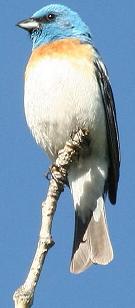Lazuli Bunting 
Lazuli Buntings can be attracted to your yard with seed
feeders, water, and a little shrubbery.
Identification and Pictures
(Passerina amoena)
 Lazuli
buntings
were named for the gemstone lapis lazuli. Lazuli
buntings
were named for the gemstone lapis lazuli.
They are a small bright blue finch about 5 to 5 1/2 inches.
Like other finches their conical bill is useful for both
insects, and seeds. The head and upper parts of males in breeding plumage are turquoise blue with black in front of the eyes.
The breast, and sides have a
cinnamon band, and the belly is white. They have black tails, and wings, with white wing bars.
Lazuli buntings look
somewhat like Western Bluebirds, but are smaller.
Young males look like the adults but are paler, and have buff feather tips.
Females are brownish with white on the throat, and belly and white wing bars.
Photos by Keith Lee. The camera I use is
the Canon EOS
40D and a 70 to 300 zoom lens.

Songs and Calls
The Lazuli's song is a rapid, high warble, similar to that of the
Indigo Bunting but longer, and with less repetition.
High phrases at different pitches like see-see, sweet-sweet, cheew
cheew, that are usually paired . By the
first or second year males will develop their own song, and will sing only that song for the rest of their life.
Often they will develop their song by listing to nearby males, so males in a certain area may sound alike.
In poor light
you may only have its song, and its silhouette for identification.
Bunting Song
Range, Habitat and Migration
Lazuli buntings range from British Columbia across Saskatchewan,
then south through the western United States.
After breeding season they begin to molt. They will stop molting while they fly in flocks to areas such as southern Arizona and New Mexico for a stopover before
continuing on with their migration south to Mexico for the winter.
The preferred habit for Lazuli buntings is shrubby areas, brushy slopes, dry hillsides, briars, and
streamside. They may also reside in residential gardens.
Breeding and Nesting
After the female chooses a nesting site in low trees or bushes she will
build a cup size nest of grass, leaves, and bark. The nest is lined with fine grass, and hair, and may be
wrapped in caterpillar silk. She will lay 3 to 4 pale blue eggs, and incubate them for around
12 days. The young birds will leave the nest in about 10 days, and the parents will feed them two or more weeks after they leave.
The
female may start another brood in which case the male will do most of the feeding.
Lazuli buntings will sometimes cross breed with Indigo
buntings.
Food, Water and Feeding
Natural foods for Buntings are seeds, grain, berries, and insects.
They can be seen foraging on the ground or in bushes, but will also visit feeders,
and bird baths in your back yard or garden area.
For more on food
and feeding go here.
For more on feeders go here.
Check out our Bunting posters
Learn about other favorite
backyard birds.

|
